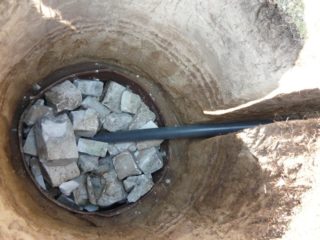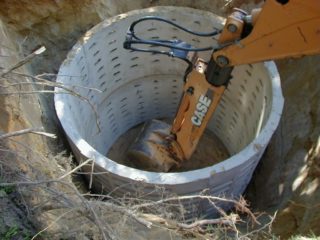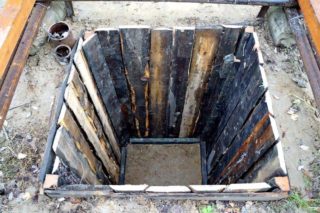The need to create a treatment facility such as a drain pit arises quite often, this is due to the lack of a supply to the sewage system. There are many varieties and methods of installing drain pits today.
A drainage pit, provided that it is correctly installed, allows substances to be partially absorbed into the ground without harm. The popularity of such a treatment plant is primarily due to the simplicity and speed of installation. Given the lack of additional assistance, one person is able to complete the entire scope of work within a few days.
Where to start
A drain pit installed in a private house must provide filtration of waste water, be equipped with a gas outlet pipe, since methane gas is generated during waste processing. The bottom of the pit is filled with rubble to filter the sewage, which falls into the tank through the sewer pipe. This simple design is suitable for houses that are rarely used. With active use, the drain pit will constantly fill up, which will require frequent cleaning.
Most often, a simple design is used in summer cottages, because living in them is inconstant. But even a simple design requires taking into account some nuances:
- Reinforced pit walls - water can provoke a collapse, therefore, various tanks, concrete rings, and brickwork are used.
- Correct calculation of the volume of the pit, most often 3 cubic meters or more. As a rule, 1 cubic meter for 1 person.
- Increase the rate of recycling with ventilation.
Drain pits can be divided according to the type of execution: accumulative made of concrete, brick, temporary and with water drainage into the ground.
Concrete drain pit
Brick drain pit
The use of ceramic bricks will allow you to get a durable and solid building, which is the most suitable option. The construction process includes several stages. The bottom of the pit is sown with crushed stone and sand of different fractions 20 cm thick. When laying bricks, leave a gap of 5 cm on the sides. From the outside, crushed stone of a coarse fraction is poured. When building such a treatment plant, you should not save by making 1/2 brick masonry. The overlap may be too heavy, which will lead to the destruction of the structure.
Drain pit made of wood
Temporary drain pit
The design can be built from a variety of suitable items. For example, used car tires. The disadvantages of using tires include a small inner diameter, as a result of which the pit will quickly fill. However, such a pit is built quite quickly and does not require much effort. The advantage is the low cost or no cost at all. The design is limited in use and cannot be used to drain the wastewater of the entire house due to its small volume.
To increase the efficiency of processing and the durability of the pits, certain conditions are most often adhered to:
- Bottom drainage should be 10 cm or more to prevent premature filling.
- Installing asbestos pipes on the bottom with a 50 cm ledge in a vertical position will improve drainage.
- If the drain pit is not large enough, the design can be complicated. Having dug an additional hole, it must be connected to the first.
- The overlap of the pit cannot be done below ground level, otherwise it will overflow during the rain.
- Installation of ventilation openings to remove accumulated gases.
You should not start building such a structure if the details are not thought out. The required volume will depend on the frequency of use. The selected type of structure will affect the financial investment. Sometimes a temporary structure is sufficient, and in some cases it will not be acceptable.











